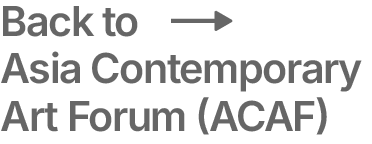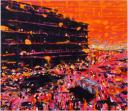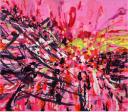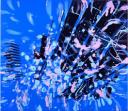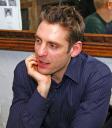Interview with John Jurayj
1. How did you start making art?
As a child I was obsessed with construction and demolition, I could not tell them apart. I started out studying architecture; maybe it was the right thing to do, the right way to be correct and inline. But when I was 18, I met a painter in Rome, His name was John. I feel in love with him. I thought, yes, that’s who I am.
2. Briefly describe your art from the perspective of what it could tell
us about you?
I think a more interesting way to think about this question would be to list my influences. The list might start with David Bowie, the Velvet Underground, Madonna and leap to Michelangelo Pistoletto, Gerhard Richter than jump to Gustave Courbet, Turner and the writings of Edward Said.
3. What experiences have most influenced your choice of subject matter,
medium and style?
I straddle two cultures; I am an outsider in both. Where do I stand? I am close yet distant. I am never quite at ease.
4. Is your formal or informal training as an artist useful? How?
I think that re-arranging the family house as a child, moving the furniture, re-positioning the objects, that was probably my most important training. It allowed me a broad yet contained canvas.
5. Does your work reflect issues in yourself, in society or community?
What would you say is the purpose for making art?
I am enamored with the object. In an age where meditation is ubiquitous, I find the possibilities of the object extremely radical. It is irreducible in its materiality and uniqueness. In the end its power is in its reality. It is always now. At the same time mediation is constantly occurring, effecting how we see and experience the object, the now.
6. Do you appreciate culturally specific works of art? If so how does
your personal and cultural background show up in your work?
I appreciate any work of art that feels necessary. It could be a Shirin Neshat video or a jar of marbles by Tony Feher. The drive behind the work has to come through or else it is dead.
7. Is there anything you would like to say about your local art scene or
the international art market, art education, and or system for art
exhibition?
I find the contemporary art world (in New York) boring and depleting. There is so much else out there, outside this small school yard, market driven environment of who is the in crowd, who is cool and popular, who sells. You know it is funny, I went to my 20th high school reunion just to see who all these people were that I had given so much power to when I was 15. All the girls and boys I had crushes on, all the people I felt rejected by, all the people I was afraid of and looked to for validation. I found them all, and many of them hadn’t changed a bit (it was unnerving), I could clearly see how small and dull they were. The people that had seemed so attractive 20 years ago had turned out banal, common even ugly (I guess there beauty was only meant for high school). It was the people that were the geeks, un-cool and weird at 15, they had grown into their own substantive beauty. I had changed.
8. How does your current portfolio fit into the rest of your body of work?
I have chosen to include a couple of my large scale oil paintings and the piece “15 Untitled Men” on this website. I think Bowie says it all:
“I, I can remember
Standing by the wall
And the guns shot above our heads
And we kissed as though nothing could fall
And the shame was on the other side
Oh we can beat them forever and ever
Then we could be heroes, just for one day”
Excerpt from David Bowie’s “Heroes”, 1977
My hope is that both patriarchy, its failures, destruction, dislocation, instability and an insidious intoxicating beauty can all exist within the same pictorial frame. The work “15 Untitled Men”, is a series of gunpowder images that depict key power players of the Lebanese civil war (1975-1990), including Yasser Arafat, Menachem Begin, Hafez al-Assad, Pierre Gemayel. The series is continuing to grow with the inclusion of Ronald Reagan, George Bush Senior and Alexander Hague. The project is not a definitive lineup but is a growing curation of portraits. Scaled to the size of an embassy portrait, these “negative ghost images” -screened on mirrored stainless steel- posit a compressed Oedipal space of father, son and viewer. Violence is inscribed throughout on multiple levels of time, form and image. It is represented as both a past event (the burning of the eyes on the initial digital images) and an ever-present future possibility (the potential explosiveness of the gunpowder surface). Mirror polished stainless steel is a material used in place of glass in penal institutions and psychiatric units for safety precautions, thus it reflects the weight of social transgression and otherness. These “ghost” images literally explode and collapse the platonic integrity of any one individual painting. Each work is in a continuous alteration by the viewer – the reflection of the other in the eyes of the men.

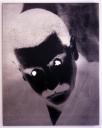
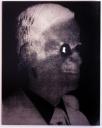

A Special Kind of Wasteland: John Jurayj’s Paintings of Beirut by Shiva Balaghi (pdf)
The Art of Destruction by Kaelen Wilson-Goldie in The National (pdf)
John Jurayj in Daily Serving (pdf)

